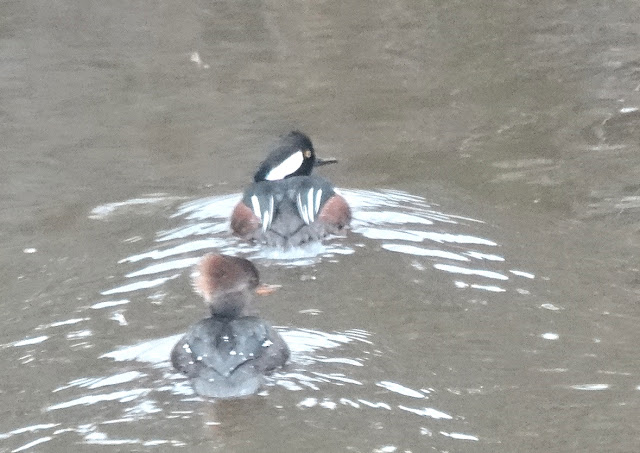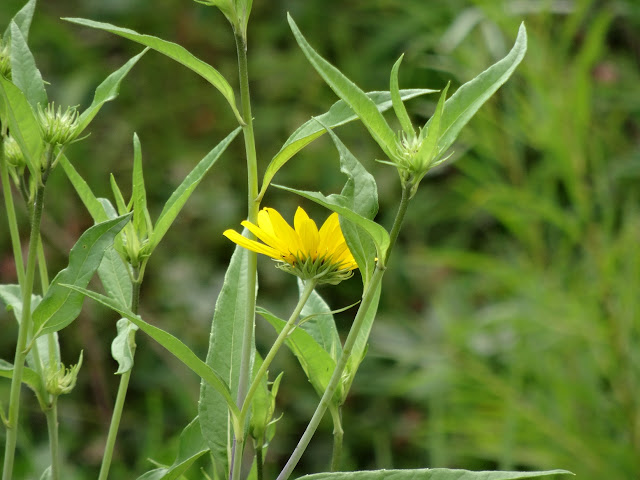Tree Swallows Tachycineta bicolor have arrived after migrating from southern USA or Mexico where they spend winter. This bird showed off his iridescent dark blue feathers while taking a rest on a branch over the pond. Tree Swallows feed on flying insects that they catch on the wing.
4/30/2020
4/22/2020
mallard
Female Mallard frolicking on the water? Not a frolic -- she was having a bath. Standing on a submerged rock, she dipped her bill and dabbed her feathers with water. Later she swam to the shore and tidied herself on the sunny grass. Ducks such as Mallards (Anas platyrhynchos) have a preen gland that produces oil. Using the bill, they smooth their feathers and spread the preen oil to condition them. All birds need to maintain their plumage . . . re-position feathers, interlock feather barbules that have become separated, and remove parasites from their body or plumage.
4/17/2020
Hooded Merganser defending territory
Hooded Mergansers have been visiting the pond to dive and feed underwater. Some days, two pairs show up; there seems to be room for all of them on the pond. But when a bachelor shows up by himself, and swims too close to a female, the paired males signal him to go away.
4/16/2020
muskrat tail
The muskrats are nocturnal; we usually see them around the pond later in the day.
Muskrats use their tails as rudders to steer themselves in the water and for a little extra propulsion.
Their tails have scales instead of fur. A muskrat tail is long, thin, and roundish, flattened side to side.
Muskrats use their tails as rudders to steer themselves in the water and for a little extra propulsion.
4/14/2020
Blue-winged Teal
Blue-winged Teal are also dabbling ducks, but smaller than the Mallards we frequently see on the pond.
They eat vegetation and grains, but in nesting season look for aquatic insects and larvae, crustaceans, clams, and snails.
This male was accompanied by a female and she wandered into the reeds to feed there.
4/12/2020
spring thaw
The pond is thawed out, except for a bit of ice on the edges in the morning. The mallards dabble close to shore, or rest and preen on last year's dried vegetation. Occasionally, a few Canada Geese drop in to see what's up on the pond. Mostly, they wander around on the boulevard grass, honking at one another.
4/11/2020
Goldfinches - one of two annual molts
American Goldfinches (Spinus tristis) are changing into their springtime molt, from drab to brilliant. They are among the few birds that refresh their feathers twice a year. In spring, they shed all except the wing and tail feathers. This is how they change to bright yellow for mating season. After nesting in summer, they prepare for surviving winter by molting all feathers.
4/10/2020
foursome for lunch
We've seen a pair of Hooded Mergansers on the pond each day at various times.
This time, two pairs find lunch on the pond.
They come and go, so probably making the rounds of all the underwater buffets.
We are looking forward to nesting season; this species usually look for a cavity to lay their eggs.
4/08/2020
turtle pile
4/03/2020
bufflehead
Buffleheads Bucephala albeola, small diving ducks, are migrating through Minnesota now. They nest north of here, so I assume these two males stopped today for rest and food. The pond is a perfect place for a respite on a cold snowy day. Maybe they found it warmer under the surface; they seemed to stay under for 12-15 seconds. Judging from the geese and other ducks feeding here, the Buffleheads must be finding nourishment as they dive in the pond. I was trying for a photo of both, but they were constantly diving again, and too quick for me.
3/27/2020
merganser pair
A pair of Hooded Mergansers Lophodytes cucullatus stopped on the pond for a few hours. They are "diving" ducks - - each dives totally under the water to eat vegetation. They also will eat small fish, aquatic insects, crayfish, amphibians, and mollusks. Their eyes are specially adapted to seeing underwater. They locate prey by sight, and propel themselves with their feet. Grasping prey underwater is easy with their long, slender, serrated bill.
3/24/2020
mallards on pond
First mallards this Spring on the pond. They both look healthy and robust, ready for nesting season.
3/14/2020
muskrat on the pond
Muskrat (Ondatra zibethicus) lives in marshes, ponds, and other wet areas. At first, we thought this might be a beaver, but it is only 14 inches long and a rounded 'rat' tail. Muskrats eat roots and stems of wetland plants plus snails, crayfish, fish, frogs.
2/29/2020
Chickadees at feeder over the pond
Black-capped Chickadees stay in Minnesota all winter. They eat seeds and insects or larvae when they can find any. They come to feeders where I offer sunflower seeds, safflower seeds, and peanut chips. This feeder hangs over the pond with an extra branch for the birds to perch on.
From November to April I watch, count, and report the birds I see as a citizen scientist. Cornell Lab of Ornithology is replete with data and information about birds. https://www.birds.cornell.edu/home
This pond is covered with snow, and a layer of ice under that. The turtles are hibernating below in the mud. The muskrats are snug in their burrows. It looks quiet and peaceful on the pond, but there is a lot going on in all seasons.
2/21/2020
snowy pond February
How different the same view looks in winter! Still, we see evidence of critters who live at the pond by their tracks in the snow.
2/10/2020
feeding birds on the pond
Chickadees, house finches, juncos, and even downy woodpeckers venture out of the trees nearby to take seed at the feeder next to the pond.
12/31/2019
winter feeder
The seed feeder hangs on a pole. I attached a forked tree branch so the birds have something to perch on. In this grey winter landscape, it is hard to spot. But the birds find it easily.
11/07/2019
doves
The seed feeder and suet cage are out, filled, and waiting for birds. So far, the only obvious visitors are two Mourning Doves. They sat on the deck rail for a while, warming themselves in the sun.
10/06/2019
10/01/2019
rest stop
Occasionally, Canada Geese land on the pond to feed on pondweed or take a rest during migration. These five stopped for just an hour.
9/05/2019
Ironweed
Tall and graceful on purple stems, Ironweed Vernonia fasciculata blooms in late summer. This clump stands on the western edge of the pond in full sun. It is a host plant for American Painted Lady butterflies, and of value for native bees.
8/28/2019
2019 - FIRST POST FROM WETLANDS
Wetlands will now be included in this blog, since my windows now look out on a pond. My new location is another former farm field that became a neighborhood. Fortunately, the pond was preserved. It is surrounded by wildflowers, grasses, trees, and reeds.
8/18/2018
2018 -- sunflower seeds LAST POST FROM WOODLAND GARDEN
Sunflowers have bloomed, and the seeds are ripe. Usually the Chickadees, with their extreme curiosity, are the first to inspect the seedheads. But the Goldfinches are the true connoisseurs of sunflower seeds fresh from the seedhead. I've noticed they usually hang around on a seedhead for quite a while, and use a horizontal leaf as a shelf to help enjoy the treat.
The scientific name of Sunflowers, Helianthus, is from Helia for "sun" and Anthus for "flower".
8/13/2018
nectar
Monarchs are finding the
Joe Pye Weed and milkweed plants in the yard.
This one even found the sweet nectar in the hummingbird feeder.
Subscribe to:
Posts (Atom)























